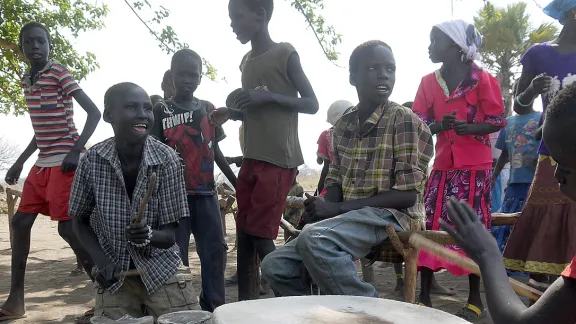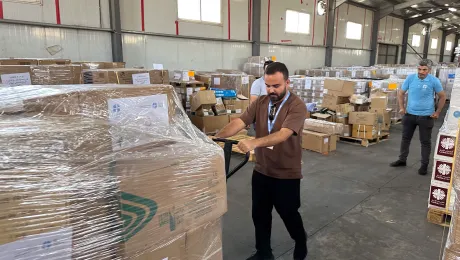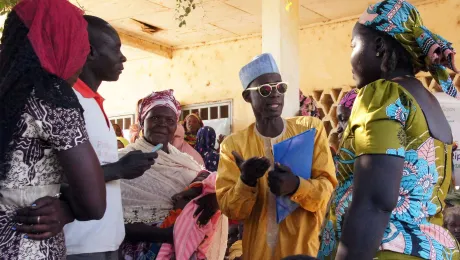
South Sudanese children at a refugee settlement in Adjumani, Uganda. Photo: DCA/ACT/LWF/Mai Gad
LWF Increases Support to Influx of South Sudanese in Uganda
(LWI) – “I am grateful for the support. Before I was sleeping under a tree in the shade with my children, now I have a plot of land, and I have just received cups, plates, blankets and things that will help my family. But I am not sure how I shall manage to build a new home without my husband,” says Achol Thon, as she waits to receive non-food items distributed to South Sudanese fleeing violence at home and seeking refuge in neighboring countries.
Together with thousands of other refugees, the 25-year-old mother of 10 month-old twins and two other young children was forced to flee to Adjumani district, northern Uganda, after fighting erupted last December in South Sudan’s capital Juba and spread to other areas of the world’s youngest nation.
Thon currently resides at a center in Nyumanzi, Adjumani district. It is one of several refugee settlements in Uganda, a country hosting more than 79,200 South Sudan refugees, of which 87 percent are women and children, according to the United Nations High Commissioner for Refugees (UNHCR).
At the centers in Nyumanzi and Dzaipi, home to over 50,700 South Sudanese, The Lutheran World Federation (LWF) is scaling up its support to the refugees by providing more water boreholes, hand-washing and bathing facilities, latrines, non-food items including household and community shelter kits, and securing the centers’ perimeters.
In Uganda, LWF’s response to the current South Sudan crisis is carried out by the Department for World Service (DWS) program there, with support from partners in the global ACT Alliance network, and in close collaboration with UNHCR.
At the settlement in Nyumanzi, Thon was waiting at a relief items’ distribution area that was still under construction, and the crowded queues included special lines and shady areas for pregnant women, mothers with babies and people with special needs.
“I came from Bor in Jonglei State. I was in my home when I could hear the gunshots and I ran with my children. My husband was not at home. He has remained in Bor,” she says.
“I depend on organizations to help me right now. I hope my future will be bright; here I have found help,” she adds.
Beyond the 60,000 Projected
However, more funds are required to help the young mother and other vulnerable groups in Uganda, which accounts for more than 80 percent of South Sudanese fleeing into neighboring countries, says Mr Jesse Kamstra, LWF country representative for Uganda and Burundi.
Kamstra points out that the number of South Sudanese recorded to date in Adjumani, Arua, Koboko and Kiryandongo districts in Uganda “surpasses by far” the 60,000 projected by UNHCR for end of March 2014.
With support from its partners, LWF is increasing its refugee response capacity to cater for the recent influx in all the centers in Adjumani. “We need to scale up our personnel and operations in the water, sanitation and hygiene (WASH) sector; distribution of non-food items; livelihood support and environmental care; community services and protection; provision of education materials; and infrastructure development,” he adds.
By mid-February, LWF Uganda had distributed thousands of cooking and serving utensils, sleeping mats, beddings and mosquito nets, plastic sheets for shelter, seven tons of laundry soap and over 1,000 plastic water jerry cans to over 32,000 refugees. In Nyumanzi, 10 community shelters (capacity for 120 per tent) have been constructed, three new boreholes have been drilled and four more have been rehabilitated.
Still, there are many urgent gaps including renovation of the health center at Dzaipi, and the construction of up to 6,000 latrines and 600 additional hand-washing facilities in the Nyumanzi settlement, Kamstra notes.
Responding to a Regional Crisis
The UN Children’s Fund (UNICEF) estimates that around 150,000 South Sudanese could arrive in Uganda by the end of March 2014. In addition, renewed fighting in the Democratic Republic of Congo has recently pushed 4,500 people into central and southwest Uganda, Kamstra adds.
Mr Michael Hyden, humanitarian coordinator at DWS, explains that the LWF has opted for a coordinated regional response to the current crisis, and is working through its country programs in Kenya, Ethiopia and Uganda, as well as inside South Sudan in order to provide protection and assistance to affected populations.
Yet, there are many challenges. Citing the example of Adjumani, Hyden says the transit centers where refugees are first received were not built to accommodate “anywhere near the number of people currently arriving.” In addition, the former refugee settlements where LWF Uganda worked with Sudanese refugees in the 1990s, and which are accommodating some of the new arrivals today, lack roads and water points.
“It is not only the refugees who are starting from scratch. Humanitarian agencies including the LWF are also racing to respond to the growing influx,” he notes.
But progress is being made, as “we see new organizations supporting the humanitarian efforts, more boreholes being drilled, and additional groups of people being transferred to the settlements,” Hyden adds.
UN sources estimate that 729,000 South Sudanese have been internally displaced in the current crisis, while more than 125,000 have sought refuge mainly in neighboring countries.
(Mai Gad, communications officer for DanChurchAid and LWF Uganda staff contributed to this article.)


